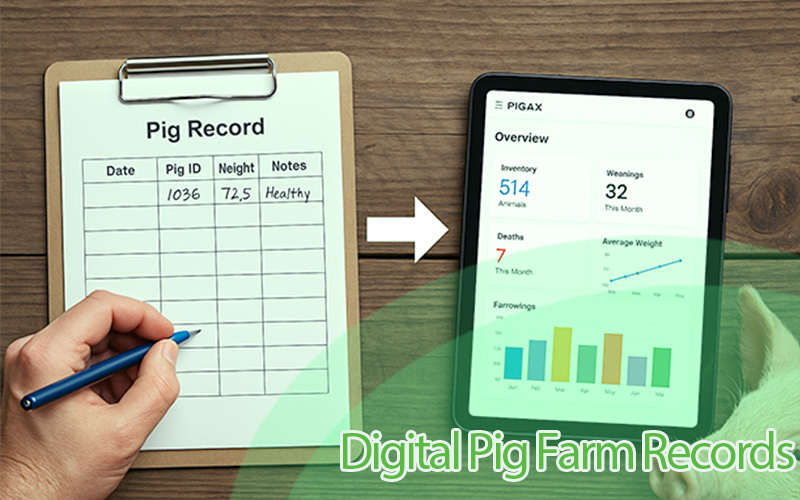How to Maintain a Cost Per Pig Record
The operational costs of raising pigs can vary greatly, farmers must ensure their production costs do not exceed the market price to make a profit. This is where the concept of "cost per pig records" becomes indispensable.
Imagine running a farm without knowing exactly how much it costs to raise each pig. Without this knowledge, it would be nearly impossible to determine whether you're making a profit or operating at a loss. The market price for pigs fluctuates based on supply, demand, and other economic factors. Therefore, understanding and managing the costs associated with raising individual pigs on the farm is crucial for any farmer aiming to succeed in this competitive market.
By meticulously tracking every expense, from feed and veterinary care to labor and utilities, farmers can gain a clear picture of these operational costs. This detailed record-keeping allows farmers to identify areas where they can cut costs, optimize their operations, and ultimately increase their profitability.
Now let's explore further the concept of cost-per-pig records, exploring what they are, why they are essential, and how to maintain them effectively. By the end of this guide, you'll have a comprehensive understanding of how to manage your farm's finances more efficiently and make informed decisions that can lead to greater success in the pig farming industry.
What is Cost per Pig Records?
Cost per-pig records are the tracking and documentation of all expenses associated with raising each pig on a farm. These records encompass every cost factor, providing a comprehensive view of the total investment needed to bring a pig from birth to market.
Components of Cost per Pig Record
- Feed Costs: This includes the cost of purchasing feed, which often constitutes the largest portion of the overall expenses. For example, if a farmer spends $300 on feed per pig, this cost must be tracked accurately.
- Veterinary Care: Regular health check-ups, vaccinations, and treatments for illnesses or injuries. For instance, a vaccination program might cost $20 per pig annually.
- Labor Costs: Wages paid to farm workers. If a farm employs workers at $15 per hour and spends 10 hours per pig over its lifecycle, labor costs would be $150 per pig.
- Utilities: Electricity, water, and other utilities used in the pig farming process. If the farm's electricity bill averages $500 per month and the farm raises 100 pigs, the utility cost per pig would be $5.
- Transportation: Costs related to transporting pigs to markets or slaughterhouses. For example, if transportation costs $200 for a batch of 20 pigs, the cost per pig would be $10.
-
Why Keep Cost per Pig Records?
Accurate cost records help in maintaining financial transparency and tracking. They enable farmers to identify cost-saving opportunities and reduce waste. For example, if feed costs are higher than expected, farmers can explore bulk purchasing options or alternative feed sources to reduce expenses.
These records facilitate informed decision-making regarding investments, scaling, and resource allocation. For instance, if veterinary costs are consistently high, a farmer might invest in better preventative care measures or seek alternative suppliers for medications.
Maintaining cost-per-pig records helps in monitoring the performance and growth of pigs. For example, if feed costs increase but pig growth rates do not improve correspondingly, it may indicate an issue with feed quality or quantity.
apart from operational benefits, accurate cost records are essential for regulatory compliance and reporting. They also assist in securing loans, grants, and investments by providing detailed financial data. For instance, banks and investors often require detailed financial records before approving funding.
Tips to Maintain a Cost Per-Pig Record
Regular Updates:
- Maintaining up-to-date records is crucial. Set a regular schedule for updating records, whether daily, weekly, or monthly. For example, every Monday morning could be dedicated to updating all cost records from the previous week.
Detailed Tracking:
- Track all costs in detail, including minor expenses. Use categories and subcategories for better organization. For example, feed costs, have subcategories for different types of feed (grain, supplements, etc.).
Use of Technology:
- Utilize pig farm management software or apps for efficient record-keeping. Digital records are more accessible and easier to analyze. For example, software like Pigax can facilitate many aspects of cost tracking.
Training and Involvement:
- Train farm staff on the importance and methods of cost tracking. Encourage involvement and accountability among all staff members. For example, have regular meetings to review cost records and discuss ways to improve efficiency.
Review and Analysis:
- Regularly review and analyze cost records to identify trends and anomalies. Use data for strategic planning and forecasting. For example, if electricity costs spike in the summer, consider investing in energy-efficient cooling systems.
Backup and Security:
- Back up digital records regularly and ensure data security to prevent loss or unauthorized access. For example, use cloud storage solutions with robust security measures to protect your financial data.
Conclusion
Maintaining cost-per-pig records is essential for effective financial management, informed decision-making, and overall farm profitability. By tracking every expense meticulously and using this data to optimize operations, pig farmers can ensure they remain competitive and successful in the market. Start improving your cost-tracking practices today and see the difference it makes in your farm's performance and profitability.




